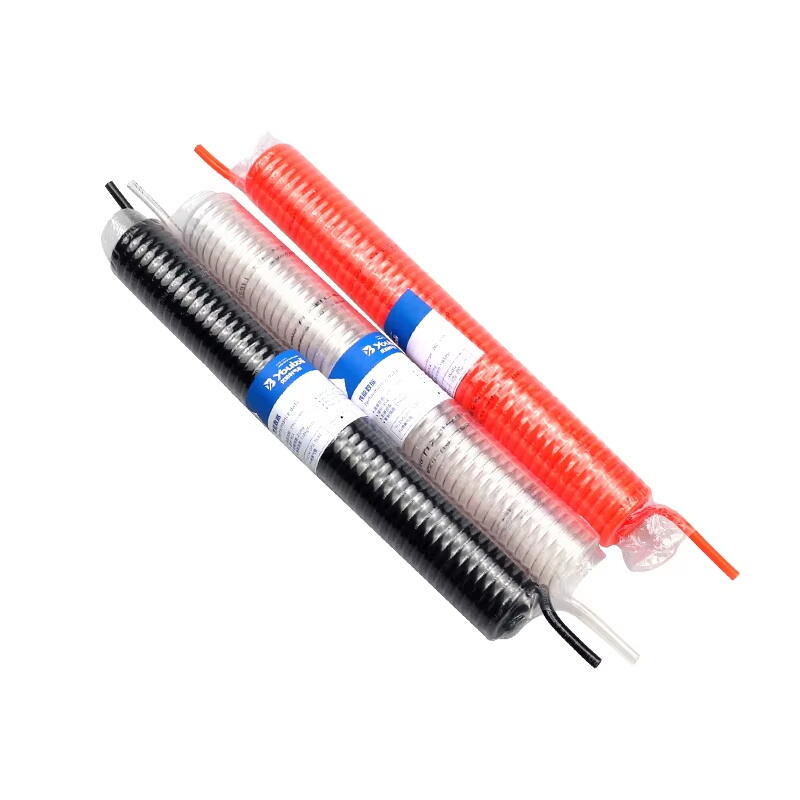Introduction to Pneumatic and Hydraulic Hoses
Roles in Fluid Power Systems
Fluid power systems are crucial in various industrial applications, providing a foundation for operations in sectors such as construction, manufacturing, and automotive. These systems leverage both pneumatic and hydraulic technologies to transmit energy effectively. Pneumatic hoses play an essential role in delivering compressed air to components like valves and actuators, making them vital for efficient operations in automated systems. Hydraulic hoses, on the other hand, are central to transmitting fluid to power heavy machinery such as pumps and motors. An increase in the building and manufacturing industries signifies the robust growth of fluid power systems, as evidenced by industry reports forecasting a CAGR of 4.4% in the hose pipe market from 2023 to 2032, highlighting their expanding significance in the industrial realm.
Overview of Pneumatic vs. Hydraulic Technology
Pneumatic and hydraulic technologies form the backbone of many industrial processes, each utilizing distinct methods for power and energy transmission. Pneumatic systems, which have evolved significantly since their early industrial use, rely on compressed air to generate motion, making them ideal for applications requiring clean, lightweight power such as packaging and robotics. Hydraulic systems, dating back to ancient times, utilize pressurized fluids for power transmission, allowing for precise control and high-force applications critical in construction and heavy machinery. For instance, automotive assembly lines optimize pneumatic tools for speed, whereas hydraulic systems are preferred for tasks demanding substantial power and precision. Case studies illustrate how industries leverage these technologies to enhance operational efficiency, such as using hydraulic systems in cranes and pneumatic systems in controlled environments like food processing.
Key Differences Between Pneumatic and Hydraulic Hoses
Pressure Tolerance: High-Power vs. Low-Pressure Systems
Hydraulic hoses are designed to handle high-pressure applications, typically exceeding 3,000 psi and even reaching up to 10,000 psi in extreme cases, according to industry standards such as ISO 18752. These hoses are essential in industries like construction and mining, where significant force is required for operations involving lifting or heavy machinery. In contrast, pneumatic hoses operate at lower pressures, generally up to 180 psi, making them ideal for applications in robotics, assembly lines, and precision tools like air drills and hammers. The lower pressure tolerance in pneumatic systems is crucial for maintaining safety and efficiency in such environments.
Material Construction: Reinforced Layers vs. Lightweight Flexibility
The construction of hydraulic and pneumatic hoses varies significantly to meet their specific functional requirements. Hydraulic hoses are typically crafted from reinforced materials, including synthetic rubber and layers of steel wire, to withstand high pressures and prevent bursting. This robust construction is vital for durability in demanding environments. In comparison, pneumatic hoses often utilize lightweight materials such as polyurethane or nylon, offering flexibility and ease of handling. These materials ensure that pneumatic hoses are well-suited for applications where maneuverability is crucial. The different material compositions result in varied performance characteristics, where hydraulic hoses provide strength and pneumatic hoses offer flexibility.
Fluid Compatibility: Oil Resistance vs. Air/Gas Applications
Hydraulic hoses are engineered to handle a range of hydraulic fluids, including oils and fuels, and must exhibit strong oil resistance, according to SAE J517 standards. This fluid compatibility is essential for maintaining hose performance and preventing failures in hydraulic systems. On the other hand, pneumatic hoses are designed for air or gas applications and must maintain integrity under these conditions. Incompatibility between hoses and the fluids or gases they transport can lead to premature wear and performance issues. Real-world examples highlight instances where improper hose selection led to decreased longevity and efficiency, emphasizing the importance of choosing the right hose for specific fluid compatibility requirements.
Hydraulic Hoses in Construction and Heavy Machinery
Hydraulic hoses play a pivotal role in the construction and heavy machinery sectors by enabling vital machine functions. These versatile components are essential in a variety of equipment such as excavators, bulldozers, and cranes, allowing for efficient power transmission and movement. According to industry standards, efficient hydraulic systems are crucial for maintaining project timelines and reducing overall construction costs. Regular inspection and maintenance of these hoses are mandates under safety regulations in construction, ensuring both efficiency and worker safety. Organizations like OSHA enforce strict guidelines for hose maintenance to prevent failures that could lead to costly delays or accidents.
Pneumatic Hoses in Automation and Air Tool Systems
Pneumatic hoses are integral to automation systems, serving key roles in industries that rely on speed and efficiency. These hoses are often used in systems such as conveyor belts and robotic arms, offering rapid movement essential for high-speed operations. Specific tools, like air compressors and pneumatic drills, depend heavily on the quality of these hoses to optimize performance and reliability. Data from industry reports highlight a significant boost in productivity due to pneumatic systems, demonstrating their increasing importance. The lightweight and flexible design of pneumatic hoses also contributes to improved energy efficiency in these applications.
Industry-Specific Use Cases (Oil & Gas, Agriculture, Automotive)
In industry-specific contexts like oil & gas, agriculture, and automotive, hoses face unique demands and operational challenges. For example, in hydraulic fracturing within the oil and gas sector, hydraulic hoses are crucial for handling high-pressure fluid transfer. Meanwhile, pneumatic seeders in agriculture require hoses that provide precision and durability. In the automotive sector, hydraulic lifts rely on hoses for lifting heavy vehicles safely and efficiently. Industry reports indicate a growing demand for specialized hoses that meet the rigorous standards and changing trends within these sectors, underscoring the adaptability and innovation inherent in hose technology.
How to Choose the Right Hose for Your System
Evaluating Pressure and Temperature Requirements
When selecting the right hose for your system, evaluating the pressure and temperature requirements is crucial. Ignoring these specifications could lead to operational inefficiencies or even hose failures. For instance, a hydraulic hose designed for high pressure might fail under lower pressure due to mismatched temperature settings. To avoid such issues, assess the fluid's operating pressure and ambient temperature range. A common guide is to look for hoses that can withstand these conditions; for example, hydraulic hoses may need pressure ratings exceeding 3000 PSI and temperature tolerance up to 212°F.
Matching Hose Specifications to Environmental Conditions
Matching hose specifications to environmental conditions ensures longevity and efficiency. Factors such as UV exposure, chemical interactions, and physical abrasions significantly affect hose performance. Practical steps involve assessing workplace conditions: are there chemical spills, or does the layout expose hoses to direct sunlight? If yes, select hoses with UV-resistant material or chemical-resistant linings. Real-life scenarios demonstrate how ignoring these factors can lead to failures; for example, a standard PVC hose may degrade rapidly under UV exposure, causing leaks and workplace hazards.
Cost vs. Longevity: Balancing Performance and Budget
Balancing cost and longevity is a pivotal factor in hose selection, particularly across diverse applications. Investing in high-quality hoses can lead to long-term savings despite higher initial costs. Factors like maintenance practices and environmental exposure play pivotal roles in hose longevity. For instance, a hose maintained regularly and shielded from harsh chemicals is likely to outlast a cheaper counterpart. Industry data often show that the return on investment (ROI) of quality hoses justifies the upfront expenditure, offering durability and reducing replacement frequency.
Pneumatic hoses and hydraulic hoses each offer unique benefits depending on system requirements and environmental conditions. Efficient transport and durable materials make these hoses indispensable in industrial settings.
Understanding Differences Ensures Proper Hose Selection
Understanding the differences between pneumatic and hydraulic hoses is crucial for selecting the right hose for your system. The pneumatic hose is typically used for transferring compressed air in various industries, whereas the hydraulic hose is designed to handle hydraulic fluids in systems that require high-pressure resilience. Knowing these distinctions allows for better decision-making when it comes to fulfilling specific operational needs and ensuring system efficiency.
FAQ
What are fluid power systems?
Fluid power systems involve the transmission of energy through fluid mediums, such as air or oil, used in various industrial applications.
How do pneumatic and hydraulic hoses differ in pressure tolerance?
Hydraulic hoses can handle high pressures exceeding 3,000 psi, while pneumatic hoses operate at pressures up to 180 psi.
What materials are used in hydraulic hoses?
Hydraulic hoses are often made from reinforced materials like synthetic rubber and steel wire layers for durability under high pressures.
Why is selecting the right hose for specific fluid compatibility important?
Correct hose selection prevents system failures and ensures longevity by matching hoses with the fluids or gases they are designed to transport.
Table of Contents
- Introduction to Pneumatic and Hydraulic Hoses
- Key Differences Between Pneumatic and Hydraulic Hoses
- Hydraulic Hoses in Construction and Heavy Machinery
- Pneumatic Hoses in Automation and Air Tool Systems
- Industry-Specific Use Cases (Oil & Gas, Agriculture, Automotive)
- How to Choose the Right Hose for Your System
- Understanding Differences Ensures Proper Hose Selection
- FAQ

